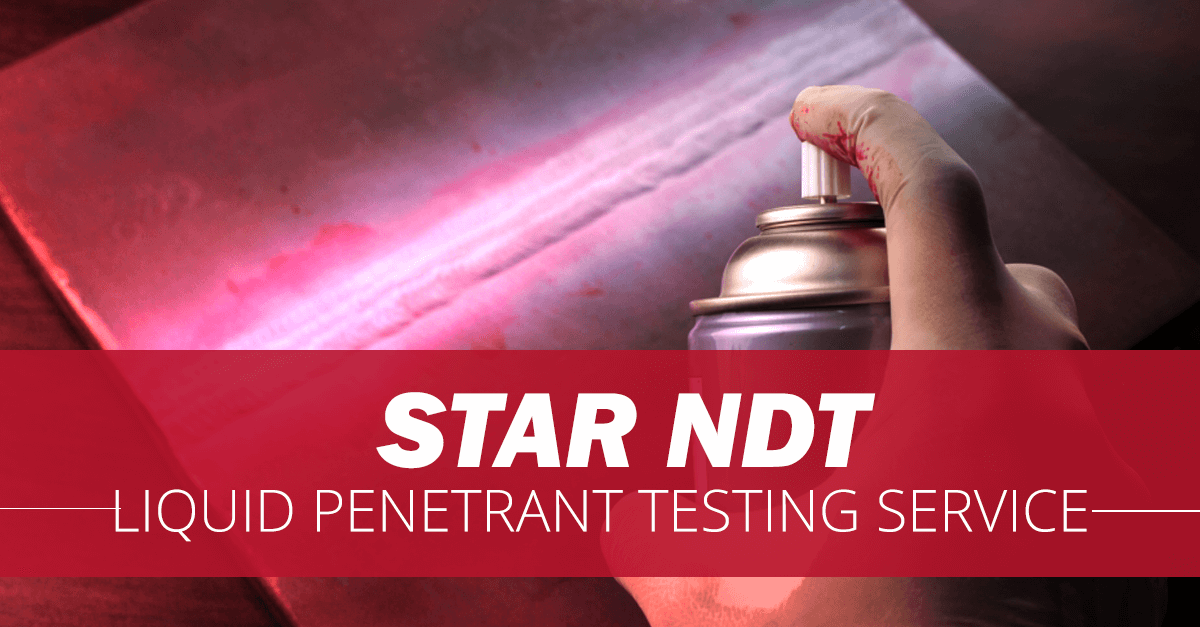LIQUID PENETRANT TESTINGSERVICES HYDERABAD
Identify defects in low-cost and widely used method…!!!

TO HELP YOU, STAR NDT SERVICESOFFERS LIQUID PENETRANT TESTING SERVICES.
Surface defects in components can mean a shutdown in production and a loss of profit. To help you stay up and smooth running, as part our non-destructive testing services, star ndt provides liquid penetrant testing, an inspection method used to locate surface-breaking defects in all non porous materials – including metals, plastics, and ceramics.
It can be applied to all non-ferrous and ferrous materials. LPI is used to detect casting, forging and welding surface defects such as hairline cracks, surface porosity, leaks in new products, and fatigue cracks on in-service components.
BENEFITS OF OURLIQUID PENETRANT TESTING SERVICES AT A LOOK
- Lower cost compared to other methods.
- Reduced risk of company accountability with documented safety standards
- Prompt results no down time, on the spot decisions can be made
HOW ITWORKS?
DPI is based upon capillary action, where low surface tension fluid penetrates into clean and dry surface-breaking discontinuities. Penetrant may be applied to the test component by dipping, spraying, or brushing. After adequate penetration time has been allowed, the excess penetrant is removed and a developer is applied.
The developer helps to draw penetrant out of the flaw so that an invisible indication becomes visible to the inspector. Inspection is performed under ultraviolet or white light, depending on the type of dye used – fluorescent or nonfluorescent (visible).
Pre-cleaning: The test surface is cleaned to remove any dirt, paint, oil, grease or any loose scale that could either keep penetrant out of a defect Application of Penetrant: The penetrant is then applied to the surface of the item being tested. The penetrant is usually a brilliant colored fluid with high wetting capability. The penetrant is allowed “dwell time” to soak into any flaws
Excess Penetrant Removal: The excess penetrant is then removed from the surface. The removal method is controlled by the type of penetrant us
Application of Developer: After excess penetrant has been removed, a white developer is applied to the sample. Several developer types are available, including: non-aqueous wet developer, dry powder, water-suspendable, and water-soluble. The developer draws penetrant from defects out onto the surface to form a visible indication, commonly known as bleed-out.
Inspection: The inspector will use visible light with adequate intensity (100 foot-candles or 1100 lux is typical) for visible dye penetrant. Ultraviolet (UV-A) radiation of adequate intensity (1,000 micro-watts per centimeter squared is common), along with low ambient light levels (less than 2 foot-candles) for fluorescent penetrant examinations. Inspection of the test surface should take place after 10- to 30-minute development time, and is dependent on the penetrant and developer used. This time delay allows the blotting action to occur. The inspector may observe the sample for indication formation when using visible dye. It is also good practice to observe indications as they form because the characteristics of the bleed out are a significant part of interpretation characterization of flaws.
Post Cleaning: The test surface is often cleaned after inspection and recording of defects, especially if post-inspection coating processes are scheduled.
USEDMOSTLY BY
Liquid Penetrant Testing is used to detect casting, forging and welding surface defects such as hairline cracks, surface porosity, leaks in new products, and fatigue cracks on in-service components.
Satisfied?Get a Quote
STAR NDT IS LEADING TEAM IN QUALITY INDUSTRY, WE PREPARE YOU IN BEST ATMOSPHERE OF TRAINING AND FLAWLESS SERVICES
contact us ABOUT US
